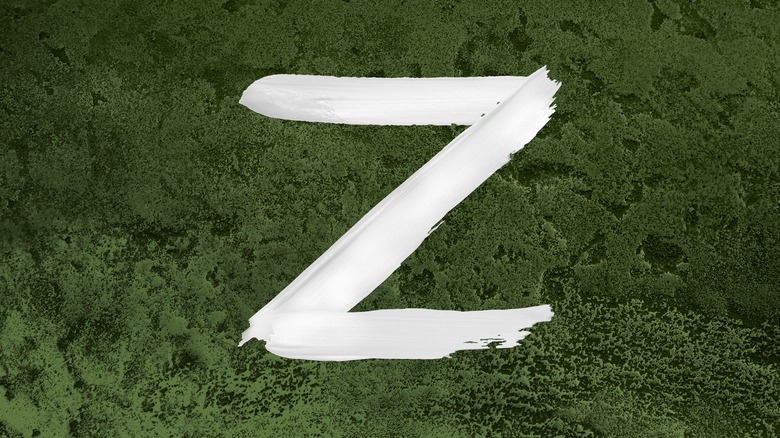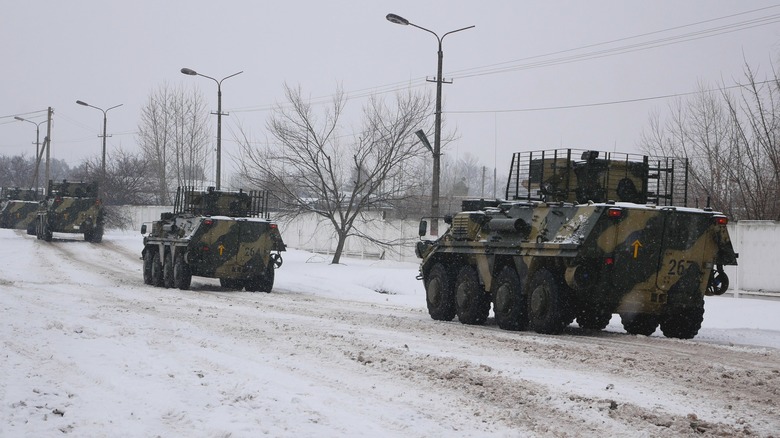Is This Why The Letter Z Is Being Used On Russian Tanks?
According to Fortune, the letter Z is not part of the Cyrillic alphabet used in languages like Russian and Ukrainian, but that didn't stop it from becoming a controversial symbol during the 2022 Russian invasion of Ukraine.
The first Zs appeared on Russian tanks and other armored vehicles during the early stages of the invasion. While other letters — including Os, Xs, As, and Vs, according to The Guardian — appeared on Russian vehicles in similar ways, the Zs caught attention of Russian supporters, and from there, merchandise bearing the symbol started appearing in Russia and among Russian supporters as the symbol became a rallying point for those in favor of Russia's actions in Ukraine. Some of this merchandise has even been sold by the Kremlin-funded state television network, RT.
More and more, Russian supporters started adopting the Z symbol. Pictures have circulated of groups of school children standing in the shape of Zs, while The National News reported that the symbol had made its way into sports. Russian gymnast Ivan Kuliak faced controversy for wearing the symbol on his uniform, despite an International Gymnastics Association ban on political symbols. Kuliak wore the symbol while taking the podium to receive his bronze medal next to gold-medal winner Illia Kovtun who hails from Ukraine, per Fortune.
Threads have also appeared on Twitter of increasing numbers of real-world examples of Z spottings on military vehicles. Insider reported that the symbol has shown up at pro-Russian rallies. One in St. Petersburg where supporters wore black hoodies with white Zs on them, while in Belgrade, Serbian far-right Russian supporters marched holding signs with the Z on them.
The origin of the Z
There are a lot of theories behind the Z symbol's meaning, and even when it first appeared. Some sources have listed the first appearance of the Z came on February 28, 2022, while others, like The Guardian, have reported that Russian vehicles with white Zs painted on them were seen as Russian forces were staging along the Ukrainian border in preparation for the invasion.
According to Fortune, it's thought that the letter didn't start as a symbol of support for the war, but instead served the utilitarian purpose of identifying different military units. Friendly fire was a major concern because a lot of the equipment used by both the Russians and Ukraine is similar in appearance, and could be hard to differentiate between the two from a distance let alone in the midst of combat, where smoke and debris could obscure vision. Some of the equipment used by Ukrainian forces is even Russian-made (via The National News). This wouldn't be anything new, as even as far back as World War II symbols on military equipment were used to quickly differentiate between friend and foe in the heat of battle.
Another explanation — which was the one issued by the Russian Defense Ministry — is that the Z stands for "za pobedu," which means "for victory." While the white Zs have caught on with non-military supporters, other Russian vehicles have been seen with large white Vs painted on them. It's thought that this is to identify Vostok East Forces, which are units from eastern Russia.
Why has the Z caught on?
Following its appearance on the battlefield, the Z was adopted by Russian nationalists, and according to The National News it's been seen on social media and has also been worn by Russian politicians.
Professor Catriona Kelly told Fortune that the Z has become a favorite symbol to supporters of Putin's aims in Ukraine not only because is it something they can rally behind, but also because it works well on merchandise. "I suppose it indicates that for a section of the Russian population, the 'military operation' is functioning something like a football championship," she said. "It probably helps also that Z looks rather like a branding device on trainers or hi-tops." She also mentioned similarities between the Z and another Russian symbol that dates back to World War II. The Ribbon of Saint George is a black and orange ribbon that became a symbol used by the Russian military that is still used today as a show of support for the Russian government. According to The Guardian, this was also a popular symbol during Russia's controversial annexation of Crimea in 2014.
Emily Ferris, a research fellow at the Royal United Services Institute offered a similar explanation to BBC News. "Often with propaganda, the simplest things catch on the quickest," she said. "It looks rather intimidating and quite stark. From an aesthetic perspective, it's a very powerful symbol."


